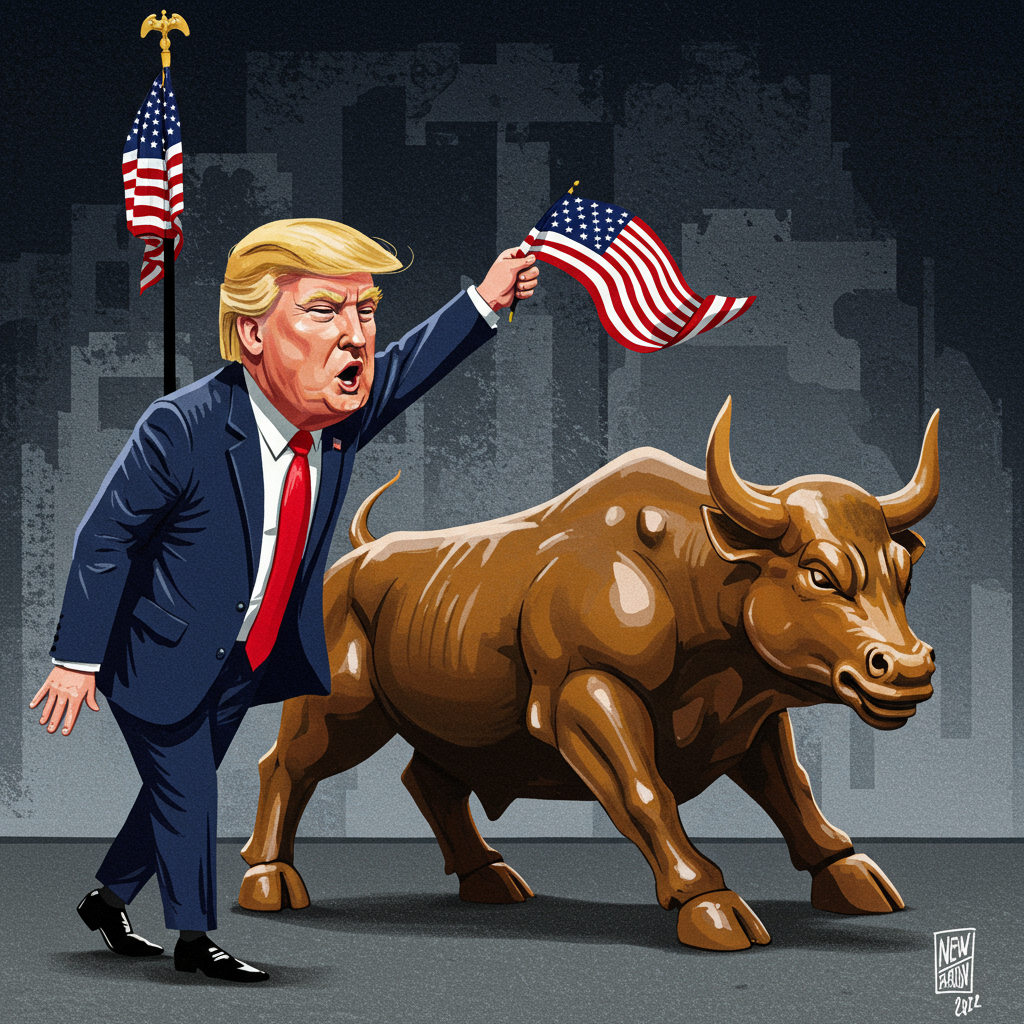Despite a wave of new import taxes, financial markets are not just holding steady; they’re hitting new highs. This unexpected resilience to President Donald Trump’s aggressive tariff policies has left many observers puzzled. Wall Street, it seems, has developed a unique coping mechanism, shrugging off announcements that once sent stocks plummeting. This article dives deep into the expert analysis, uncovering the real reasons behind the market’s calm, the economic impacts beyond the headlines, and what this all means for businesses and consumers.
The Market Paradox: Shrugging Off Tariff Threats
In recent months, President Trump has imposed tariffs as high as 50% on goods from numerous countries, including major U.S. trade partners like the European Union and Mexico. Historically, such aggressive trade measures would trigger significant market fear and volatility. Yet, in a striking departure from past reactions, stocks have largely recorded gains, even reaching record highs. Investors appear unfazed.
Experts point to a key shift in investor psychology. Bret Kenwell, a U.S. investment analyst at eToro, highlights an investor posture dubbed “TACO” – short for “Trump Always Chickens Out.” This view has gained widespread acceptance on Wall Street. Investors increasingly perceive tariff announcements as strategic diplomatic maneuvers rather than irreversible policy declarations. They anticipate that the administration will ultimately engage in negotiations, leading to a rollback or modification of the levies.
Compounding this sentiment is what Kenwell describes as “headline fatigue.” The constant flurry of trade headlines and policy proposals has led investors to view them as transient negotiation ploys. These are no longer seen as lasting threats to the economic landscape. This shift reflects a profound change in how markets process trade news.
Compare this to the market’s sharp reactions just a few months prior. In April, when President Trump announced sweeping “Liberation Day” tariffs, major stock indexes lost approximately $3.1 trillion in value the very next day. This marked their biggest single-day decline since the onset of the COVID-19 pandemic. The Dow Jones Industrial Average dropped nearly 4%, the S&P 500 fell 4.8%, and the tech-heavy Nasdaq tanked almost 6%.
However, days later, on April 9th, Trump delayed a significant portion of these tariffs. He committed to pursuing trade negotiations with targeted countries. This move prompted one of the stock market’s largest single-day increases ever. The Dow soared nearly 8%, the S&P 500 climbed 9.5%, and the Nasdaq saw a staggering 12% increase. This pattern of market volatility followed by a rebound upon a hint of negotiation solidified the “TACO” theory.
Kenwell explained that once the administration showed a willingness to negotiate, markets realized these trade policies were not an “endless run.” This understanding was further reinforced a month later. Trump established a trade framework with China, reducing tariffs on the top U.S. trade partner from 145% to 30%. On that day, all major stock indexes climbed at least 2.8%. More recently, in early June, when Trump doubled tariffs on steel and aluminum, investors showed little concern. Major indexes remained essentially unchanged, demonstrating the new normal of market indifference.
Unpacking Trump’s Tariff Strategy: Beyond the Headlines
Former President Donald Trump views tariffs as a cornerstone of his “America First economic policies.” He famously called them “the most beautiful word in the dictionary.” This approach is designed as a multifaceted strategy to reshape international trade and address various national challenges. His motivations extend far beyond simple trade economics.
A primary driver for Trump’s tariff strategy is economic revitalization and job creation. He aims to boost American manufacturing by making domestic production more attractive. By imposing taxes on imported goods, the goal is to protect American workers. It incentivizes companies to manufacture within the United States, thereby bringing jobs back. This strategy is rooted in the belief that global trade has harmed American manufacturers and workers.
Beyond economic objectives, tariffs are also employed as a tool for border security and drug control. Trump has directly linked tariffs to border enforcement efforts. He aims to combat illegal immigration. Countries like Mexico and Canada have faced pressure through trade measures to cooperate in stopping drug trafficking, particularly concerning the fentanyl crisis. This leverages America’s position as a major buyer for diplomatic influence.
Another key motivation is revenue generation and budget balancing. Trump perceives tariffs as a significant financial windfall. They can serve as an alternative revenue stream to traditional taxes and debt. The administration estimated tariffs could generate around $120 billion annually. The Committee for a Responsible Federal Budget projected that Trump’s tariffs on China, Mexico, and Canada could generate approximately $1.3 trillion over a decade. Trump even suggested tariffs could eventually reduce the need for income taxes.
Recently, Trump also announced plans for tariffs exceeding 10% on goods from “smaller countries,” explicitly naming nations in Africa and the Caribbean. While Commerce Secretary Howard Lutnick noted these regions conduct modest trade with the U.S., the move signifies a broad application of the tariff tool. Additionally, new tariffs are expected on specific industries. Pharmaceutical drugs will likely see a lower initial tariff rate, giving companies one year to build domestic factories before higher import taxes apply. The computer chip industry is expected to face a “similar style” of tariffs, also designed to encourage onshore manufacturing. This strategy highlights a consistent aim of rebalancing trade and stimulating domestic industrial growth.
The Tangible Costs: Inflation, Revenue, and Investment
While markets may appear unconcerned, Trump’s tariffs do carry tangible economic effects. Despite some rollbacks, the effective U.S. tariff rate is significantly elevated. The Yale Budget Lab found that, including recent announcements, the effective tariff rate registers at 20.6%. This is the highest such rate since 1910.
Though the U.S. economy has largely avoided a massive, tariff-induced price surge, government data indicates tariffs contributed modestly to rising consumer prices in June. The overall Consumer Price Index (CPI) rose 2.7% compared to a year prior. While this matched economists’ expectations, it marked an uptick. Notably, prices for imported goods showed significant jumps. Toys, almost entirely imported, increased six times faster in June than two months prior. Similarly, bed linens rose 5.5%, and major appliances surged 1.9%. Apparel prices also exceeded the general inflation rate. The Yale Budget Lab estimates this translates to an additional cost of $2,800 for the average household annually due to tariff price effects.
Economists like Dominic Pappalardo, chief multi-asset strategist at Morningstar Wealth, explain that companies with slim profit margins find it difficult to absorb the tariff burden. They often pass a share of the tax onto consumers through price hikes, as “they don’t have the cushion.” Despite these price increases in import-dependent sectors, the overall inflation rate remains lower than the 3% recorded in January when Trump took office.
On the revenue side, tariffs have generated substantial income for the U.S. Treasury. Data revealed approximately $27 billion in tariff-related tax revenue last month, contributing to over $100 billion year-to-date. Mark Zandi, chief economist at Moody’s Analytics, projects this revenue could surpass $300 billion by the end of 2025. This could account for nearly 1% of U.S. GDP. Some analysts suggest it could help alleviate government deficits, with Zandi noting the revenue was “more substantial than I anticipated.”
Furthermore, the White House claims tariffs have stimulated trillions of dollars in new investment across U.S. manufacturing, technology, and infrastructure. Major corporations like Apple, Nvidia, Merck, Johnson & Johnson, Hyundai, and Stellantis have made pledges. Morris Cohen, a professor emeritus at Duke University, affirmed that a core objective is promoting “reshoring of manufacturing and change the balance of trade.”
However, skepticism remains regarding the overall impact and sustainability of these investments. Matias Vernengo, an economics professor at Bucknell University, suggested that companies’ promises are often political maneuvers. He doubted many firms would fully meet their commitments, emphasizing the need for policy consistency. Zandi also expressed reservations about the long-term dependability of tariff revenue. He advised against lawmakers relying on it, given the potential for legal invalidation or future presidential decisions to modify or eliminate tariffs.
Expert Perspectives: Resilience vs. Reality
The market’s resilience, while striking, doesn’t imply an absence of economic consequences. Callie Cox, chief market strategist at Ritholtz Wealth Management, cautioned clients that tariffs are “coming due in the form of higher inflation, thinner margins, or a combination of both.” She suggested many people haven’t fully processed this reality.
Despite the recent uptick in prices, key measures of the U.S. economy have proven resilient. Fears of sky-high inflation and a possible economic downturn haven’t materialized broadly. Kenwell noted that for markets to show greater concern about Trump’s tariffs, investors would “need to see significantly higher inflation.” He concluded that “markets find a way to shrug off bad news.” This doesn’t make them “invincible,” he added, but it does make them “resilient.”
Jason Miller, a professor of supply chain management at Michigan State University, believes these price pressures are only the “opening stages of these tariff effects.” He warns that continued price increases could be compounded by another round of levies. This escalation could also be driven by importers losing their capacity to absorb the costs. Conversely, Callie Cox also presented an alternative perspective. She suggested that a potential tariff-induced economic slowdown could reduce consumer demand. This might then mitigate upward price pressures.
Looking Ahead: Key Dates and Potential Shifts
The dynamic nature of Trump’s tariffs means the economic landscape is constantly evolving. Tariffs on dozens of countries are poised to take effect on August 1st. This date could serve as a potential inflection point for the market’s perception of these trade policies. Analysts at France-based financial firm BNP Paribas expressed minor concern in a recent memo to clients. They highlighted an increased “risk of an escalatory tit-for-tat scenario.” However, they ultimately expect that “deals will be struck by 1 August to limit the further increase in tariffs.” This aligns with the prevailing “TACO” sentiment on Wall Street. The ongoing interplay between political negotiation, investor sentiment, and real economic impact will continue to shape how these policies unfold.
Frequently Asked Questions
Why do financial markets seem unfazed by Trump’s recent tariff announcements?
Financial markets are largely unaffected due to a combination of factors. Experts cite “headline fatigue,” where investors are desensitized to constant trade news. More significantly, a prevailing investor posture dubbed “TACO” (Trump Always Chickens Out) suggests that traders view tariff announcements as negotiating tactics rather than firm, long-term policies. Historical patterns have shown President Trump often rolls back or delays tariffs after initial announcements, reinforcing this belief and leading markets to anticipate eventual de-escalation.
What are the actual economic impacts of these tariffs on consumers and the U.S. economy?
While markets appear calm, Trump’s tariffs have led to tangible economic effects. The effective U.S. tariff rate is at 20.6%, the highest since 1910. This has resulted in modest inflation, particularly for import-dependent goods like toys, linens, and appliances, leading to an estimated additional cost of $2,800 annually for the average household. On the positive side, tariffs have generated substantial tax revenue for the U.S. Treasury—over $100 billion year-to-date—and are claimed to have stimulated new domestic manufacturing investments. However, economists express skepticism about the long-term reliability of this revenue and corporate commitments.
What are President Trump’s primary motivations for imposing tariffs?
President Trump’s motivations for implementing tariffs are multifaceted. A key goal is economic revitalization and job creation, aiming to incentivize domestic manufacturing and reshoring of jobs by making imports more expensive. Tariffs are also used as a tool for border security and drug control, pressuring countries to cooperate on issues like illegal immigration and drug trafficking. Additionally, he views tariffs as a significant revenue source, potentially generating billions annually to reduce national debt or fund government initiatives. He also uses tariffs as a powerful negotiating tool in international trade discussions.


